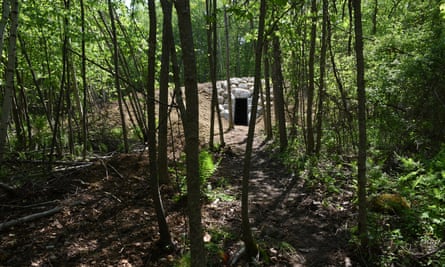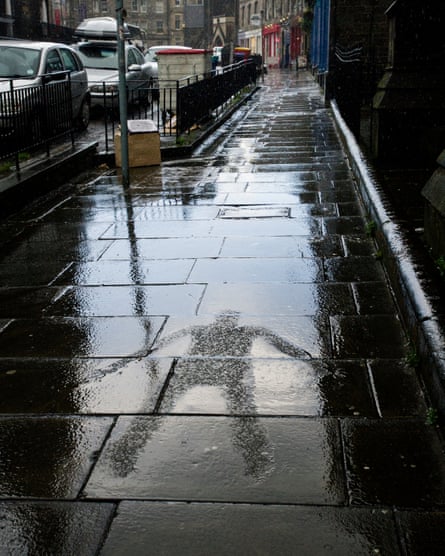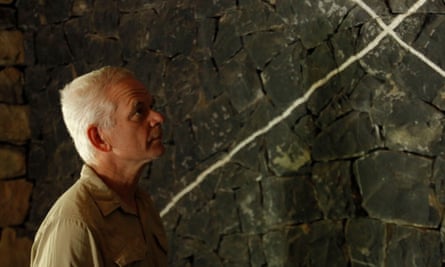Andy Goldsworthy is currently organising ambitious landscape sculptures in Ohio, New Mexico and North Yorkshire, planning forthcoming commissions in Tasmania, the Netherlands and Patagonia, as well as launching Leaning into the Wind, a new film about his artistic life. When artists become this successful, it gets harder for them to actually make art.
And yet the day before we meet at his old farmhouse near Dumfries, Britain’s best-known land artist was rearranging stones by the small burn out the back. It’s a crevice in the hill, sheltered from the sun and the wind that soughs the ash trees, and Goldsworthy points to the whinstone that litters the earth by the trickle of the stream.
“I just moved the stones and took a picture, and moved the stones again and took a picture. There’s a real flow of stones here. People moving them is very much in the spirit of this place,” he says. “I’ve always much preferred going deeper within a place rather than travelling somewhere else.”
Goldsworthy is 62; tanned, healthy and exuding vitality about the “real upsurge” in big commissions. “I’ve been working for 40 years now, so I’ve got a lot of experience, and I’m still fit enough to physically work on them myself,” he says. “It’s a very special time for all these things to happen.”

Faced with such opportunities, experienced artists may reproduce their greatest hits, or realise ideas they have “hawked around for many years”, as Goldsworthy puts it. There are “one or two” of those, he laughs – such as his “big red hill” planted with Virginia creeper, which was first devised in 1984 and finally made in Ohio last year – but most, he insists, are new and challenging.
“The ideas I’m having now are far better than anything I’ve thought of before,” he says. “Most of them I couldn’t have even conceived of 10 years ago, works that take me way out of my comfort zone.” He leans forward, suddenly intense. “The biggest failure is to make a work that is safe, that doesn’t take a risk. I’m taking big risks with no safety net.”
Seventeen years ago, his working life was beautifully documented by German film-maker Thomas Riedelsheimer in Rivers and Tides. The film was an unexpected success, but it made Goldsworthy squirm, not least for promoting an image of him as a pastoralist and guru of the wild. “I certainly felt that was a misrepresentation because for me there is a strong social nature to the landscape,” he says. “As a place to work, it is not a place of therapy and peace, it’s intellectually and physically challenging. This rather romantic view of me off by myself, with cows looking at me – well, the cows are meat and the sheep are wool and there are no trees here because the sheep are eating them all. They have had this huge historical and environmental impact but they are portrayed as woolly and cute. The landscape isn’t woolly or cute.”
Goldsworthy also rejects the view that his art should explicitly tackle environmental problems. “If I was thinking: ‘I’m going to make a work that’s going to address an environmental or ecological issue,’ I wouldn’t make a great work. It would be the wrong premise. The day I start preaching through my work is the day it stops having any meaning.”
When Riedelsheimer suggested another film, Goldsworthy wondered if it might correct the pastoral misconception. So Leaning into the Wind shows some of his more urban ephemeral work: climbing into a tree by a busy road, walking inside hedges or perplexing passersby by lying down on the pavement at the first hint of rain before rising to reveal an eerie “shadow”, which soon vanishes in the ongoing shower.

These performance pieces are uncomfortable for an artist of late middle-age, particularly because, as Goldsworthy points out, he is not a performer. “They are very personal acts done in an often public place.” Hedge walking is “pretty brutal”, he admits. “I came out of one or two of those feeling pretty beaten up. But what a beautiful thing to do. Swimming through a hedge.” He’s probably retired from hedge walking, however. “You only do them while they are giving you something. The intention of my work has always been to understand my relationship with the land. I don’t go out to improve what is there. But I do feel this need to be a participant, working with it, learning about it. Art has an amazing ability to open your eyes to what’s around you – such as the hedge. Maybe that’s what art is. It just takes you somewhere you’ve never thought of going, whether it’s in the mind or the world.”
What’s really risky, says Goldsworthy, are his increasingly monumental works. “The ephemeral work is made in the spirit of – I make mistakes, things fall down. With the permanent works, they must not fail.”

He shows me sketches for Boulder House, a 2016 dome covering a glacial rock in New Hampshire. He initially designed it with rectangular blocks of quarried stone but decided to build it with huge round boulders after he and his drystone wallers (he employs a regular team from the Peak District) used similar boulders to construct another piece. “It’s like trying to make something out of marbles,” he says. And Boulder House took months to build. “When you go inside it looks scary as hell, as if the boulders are floating above you. I wouldn’t go in there unless I had made it.”
Many of Goldsworthy’s big new works are for private clients in the United States. Does he balk at producing monuments for rich people? “It’s not for them,” he says. “It’s for the place. They can’t move it. It’s come out of their commitment to the place but it’s not theirs.” And how a work evolves is beyond the control of both landowner and artist. “When I finish the ephemeral work it decays,” he continues, whereas the moment the permanent projects are finished is the moment they begin. There’s an enormous unpredictability about what kind of life they will have. Many of the works are to be laid in, or passed through. They are dependent on the interaction of people, who are participants in the work, for their success.”
Some works, however, have “died in spirit”, he says. One of his stone walls that snakes around trees in Yorkshire is “really loved”; the other, in Grizedale Forest, Cumbria, is “dead”. Why? “It’s physically collapsed, they cut all the trees down around it, they ploughed over it, and nobody gives a shit about it.”
At the turn of the century, the Guardian’s art critic Jonathan Jones condemned the “pastoral fictions” of Goldsworthy in an interview with the then new director of the Grizedale Society, Adam Sutherland, who vowed to ban wood and stone artworks in favour of digital and performance art.

“Why do that to your collection?” says Goldsworthy. “It’s insulting isn’t it? It’s as if he [Sutherland] was trying to create this controversy to make him feel cutting edge.” Goldsworthy is spitting out his words now. “I have nothing against any cutting-edge digital whatever in there. Fine by me. It can sit alongside me but why … ? That was unforgivable really. Yes, he’s probably a big part of the death of that one.”
Since the first film, Goldsworthy’s private life has been turned upside down. His parents have died, he broke up with his first wife, Judith Gregson, with whom he has four children, and later she died in a car accident. Goldsworthy married the art historian Tina Fiske (who has co-written a book about his work) and they have a young son. His daughter Holly is now working full-time with him, overseeing his photographic work. “I never thought or expected a child of mine to work with me,” he says. Holly joined one of his projects after graduating from Glasgow School of Art. Does he worry she won’t fulfil her own artistic ambitions? “I do. I wouldn’t be against her wanting to go and do her own thing at any time.”
Goldsworthy’s work also draws in his youngest son, Joel – “he’s seven, he’s a real trooper and he comes out working with me” – and Fiske. “No one normally is more critical of what I do than Tina. She’s not always right but I love the test that she sets the work. She’s amazing, she’s very articulate and very bright and tough.”
It is also hard on his family, he says, because he is away a lot. “But they all understand I’ve just got to do it. If there is anything my art has taught me it is the right moment to make something. You’re looking for that moment and this is it.”

Comments (…)
Sign in or create your Guardian account to join the discussion